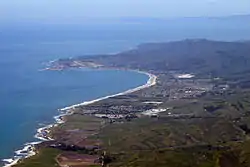Pillar Point Harbor
Pillar Point Harbor is a boat harbor created by a riprap breakwater in San Mateo County, California immediately north of Half Moon Bay. It is used by both pleasure craft and small commercial fishing boats.

The Ohlone people inhabited the region into much of the 19th century, and a number of recorded shipwrecks occurred in the immediate area. The modern harbor facilities were constructed between 1959 and 1982. The harbor facilities are managed by the San Mateo County Harbor District.
Location
The harbor is situated at the north end of the semicircular bay called Half Moon Bay, and is at the extreme north edge of the city of Half Moon Bay, the southwest edge of the town of El Granada and the southern edge of the unincorporated community of Princeton-by-the-Sea.
The big wave surfing location in Mavericks is about a half mile (1 km) outside Pillar Point Harbor.
History
Early history
Before European contact, and through much of the 19th century, the Ohlone tribe lived in the region, especially in the riparian zone of El Granada Creek.[1] The National Register of Historic Places indicates an Ohlone archaeological site, Archeological Site SMA-151, in this immediate area.[2][3][4][5] The first European land exploration of Alta California, the Spanish Portolà expedition, passed through the area on its way north, camping just south of the harbor on October 28, 1769.[6] In his expedition diary, missionary Juan Crespi described Pillar Point.
19th century
By the early 19th century Russian fur trappers plied this portion of the Northern California coast. By 1859 part of the area was owned by James G. Denniston, a California state assemblyman who represented San Mateo County.[7] He built a deep-water landing at Pillar Point which for many years was a key port for lumber, produce and other material destined for San Francisco.[8]
... a reminder of more than 85 sailing ships wrecked on the San Mateo County coastside in the last half of the nineteenth century.
— Plaque near the anchor of the Rydal Hall, [9]
Many shipwrecks and other nautical accidents occurred in this area of the Pacific Ocean coastline. The ship Rydal Hall was wrecked in October 1876 near Pillar Point while carrying coal destined for San Francisco. In 1971 the ship's anchor was recovered and is still on display outside a nearby restaurant. [9][10]
20th century

In the twentieth century the harbor was used by small fishing boats, though fierce winter storms sometimes destroyed boats even when in the harbor. From 1959 to 1961, the Army Corps of Engineers constructed a riprap breakwater to protect the harbor. [11][12] At that time a pier, the Harbor Master's office, and other facilities were also built, and a foghorn was installed.[13] However it was soon found that the breakwater did not provide protection from southwesterly storm waves, which surged through the breakwater opening. In 1967 the western arm of the breakwater was extended by 1,050 feet (320 m) in an attempt to block such waves. That solution also proved inadequate, so in 1982 an inner breakwater was built.[8][12]
The outer breakwater diverts storm waves to nearby shores, increasing erosion drastically in some places. A line of nearby bluffs eroded back 150 feet (46 m) in the 35 years after the breakwater was built, despite an attempt in the 1960s to shield the bluffs with a riprap barrier.[12]
The San Mateo County Harbor District has maintained a Harbor Master's Office and rescue station there since 1970. For almost twenty years (1978–1996) the Harbor Master, Robert McMahon and his various crews, achieved recognition from the Coast Guard for being the first responders and saving hundreds of lives.
References
- Environmental Impact Report for the Pillar Point East Harbor Master Plan, Earth Metrics Inc., San Mateo County Harbor District, February 1989
- "Archeological Site SMA-151". Office of Historic Preservation. Retrieved 10 April 2020.
- "National Register record of Archeological Site SMA-151, NRIS 78000771". NPGallery Asset Detail. Retrieved 10 April 2020.
- Gerber, Joyce L.; Price, Barry A.; Lebow, Clayton G.; Baloian, Mary Clark (April 2009). "Cultural Resources Management Plan for Pillar Point Air Force Station San Mateo County, California" (PDF). U.S. Air Force 30 CES/CEANN. Applied EarthWorks. Retrieved 10 April 2020.
- "Big Wave Wellness Center and Office Park Draft Environmental Impact Report" (PDF). San Mateo County Planning and Building Department. October 2009. Retrieved 10 April 2020.
- Bolton, Herbert E. (1927). Fray Juan Crespi: Missionary Explorer on the Pacific Coast, 1769-1774. HathiTrust Digital Library. pp. 223–225. Retrieved 18 July 2014.
- "James G. Denniston". JoinCalifornia. Retrieved 8 April 2020.
- West, Don; Cotchett, Joseph W. (2002). The Coast Time Forgot. Moss Beach, CA: Thornton House.
- "Plaque for anchor from wreck of Rydal Hall".
- "October 1876: Wreck of the Rydal Hall". Princeton by the Sea Memories. Archived from the original on 23 July 2019. Retrieved 8 April 2020.
- US Army Corps of Engineers. "Continuing Authorities Program (CAP) 111 Project, Public Meeting 8 Nov. 2013 (presentation slides)" (PDF). Retrieved 18 August 2019.
- VanderWerf, Barbara (7 Mar 1997). "Pillar Point Harbor's ever-present breakwater battle" (PDF). San Mateo County Times. Retrieved 9 Apr 2020.
- "Old salts mourn a muffled foghorn". SFGate. Retrieved 8 April 2020.
